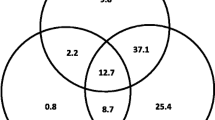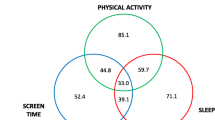Abstract
Objectives
Global childhood obesity is of great concern. In 2019, the World Health Organization released global guidelines on movement behaviors for the children under 5 y of age to combat this epidemic. This study aimed to estimate the prevalence of Vietnamese preschoolers meeting the guidelines, and examined whether guideline compliance is associated with adiposity and motor development.
Methods
A cross-sectional study was conducted on 103 healthy preschoolers who were conveniently sampled from preschools in urban and rural areas around Ho Chi Minh city. Time spent in different intensities of physical activity and sedentary behavior was measured using Actigraph GT3X + accelerometers over three consecutive days. Sleep and screen time were obtained via parent questionnaires. Children were classified as meeting or not meeting the global guidelines. Height, weight, and motor skills were measured by the research staff. Regression models were applied to quantify the association between guideline compliance and adiposity and motor development, adjusting for age and sex.
Results
While 17.5% of children met all three guidelines, 5.8% met no guidelines. The prevalences of children who met guidelines for physical activity time, sleep duration, and screen time were 50.4%, 81.4%, and 44.7%, respectively. There was no association between guideline compliance and adiposity and motor development.
Conclusion
This study found a low proportion of children who met the global guidelines, whereas a high proportion of those with overweight and obesity was reported. Health programs should promote more physical activities of various intensities in young children.

Similar content being viewed by others
Availability of Data and Material
The dataset analyzed during this study is not publicly available as we do not have ethical clearance to share this data.
References
NCD Risk Factor Collaboration (NCD-RisC). Worldwide trends in body-mass index, underweight, overweight, and obesity from 1975 to 2016: a pooled analysis of 2416 population-based measurement studies in 128·9 million children, adolescents, and adults. Lancet. 2017;390:2627–42.
Park MH, Falconer C, Viner Ra, Kinra S. The impact of childhood obesity on morbidity and mortality in adulthood: a systematic review. Obes Rev. 2012;13:985–1000.
Ward ZJ, Long MW, Resch SC, Giles CM, Cradock AL, Gortmaker SL. Simulation of growth trajectories of childhood obesity into adulthood. N Engl J Med. 2017;377:2145–53.
Hu F. Obesity epidemiology, 1st ed.NewYork: Oxford University Press. 2008.p.301-19
Carson V, Hunter S, Kuzik N, et al. Systematic review of sedentary behaviour and health indicators in school-aged children and youth: an update. Appl Physiol Nutr Metab. 2016;41:S240–65.
Chaput JP, Gray CE, Poitras VJ, et al. Systematic review of the relationships between sleep duration and health indicators in school-aged children and youth. Appl Physiol Nutr Metab. 2016;41:S266–82.
Poitras VJ, Gray CE, Borghese MM, et al. Systematic review of the relationships between objectively measured physical activity and health indicators in school-aged children and youth. Appl Physiol Nutr Metab. 2016;41:S197-239.
Saunders TJ, Gray CE, Poitras VJ, et al. Combinations of physical activity, sedentary behaviour and sleep: relationships with health indicators in school-aged children and youth. Appl Physiol Nutr Metab. 2016;41:S283–93.
Malina RM. Tracking of physical activity and physical fitness across the lifespan. Res Q Exerc Sport. 1996;67:S48-57.
Janz KF, Burns TL, Levy SM. Iowa Bone Development Study. Tracking of activity and sedentary behaviors in childhood: the Iowa Bone Development Study. Am J Prev Med. 2005;29:171–8.
Carson V, Lee EY, Hewitt L, et al. Systematic review of the relationships between physical activity and health indicators in the early years (0–4 years). BMC Public Health. 2017;17:854.
Chaput JP, Gray CE, Poitras VJ, et al. Systematic review of the relationships between sleep duration and health indicators in the early years (0–4 years). BMC Public Health. 2017;17:855.
Kuzik N, Poitras VJ, Tremblay MS, Lee EY, Hunter S, Carson V. Systematic review of the relationships between combinations of movement behaviours and health indicators in the early years (0–4 years). BMC Public Health. 2017;17:849.
Poitras VJ, Gray CE, Janssen X, et al. Systematic review of the relationships between sedentary behaviour and health indicators in the early years (0–4 years). BMC Public Health. 2017;17:868.
World Health Organization. Guidelines on physical activity, sedentary behaviour and sleep for children under 5 years of age. Geneva: World Health Organization. 2019.p.1-22
Chaput J-P, Colley RC, Aubert S, et al. Proportion of preschool-aged children meeting the Canadian 24-Hour Movement Guidelines and associations with adiposity: results from the Canadian Health Measures Survey. BMC Public Health. 2017;17:829.
Berglind D, Ljung R, Tynelius P, Brooke HL. Cross-sectional and prospective associations of meeting 24-h movement guidelines with overweight and obesity in preschool children. Pediatr Obes. 2018;13:442–9.
Draper C, Tomaz SA, Cook CJ, et al. Understanding the influence owf 24-hour movement behaviours on the health and development of preschool children from low-income South African settings: the SUNRISE pilot study. S Afr J Sports Med. 2020;32:1–7.
Chiaki Tanaka, Shinpei Okada, Minoru Takakura, et al.Relationship between adherence to WHO “24-hour movement guidelines for the early years” and motor skills or cognitive function in preschool children: SUNRISE pilot study. Jpn J Phys Fitness Sports Med. 2020;69:327–33.
World Health Organization. UNICEF/WHO/The World Bank Group joint child malnutrition estimates: levels and trends in child malnutrition: key findings of the 2020 edition. World Health Organization. 2020.
WHO Multicentre Growth Reference Study Group. WHO Child Growth Standards based on length/height, weight and age. Acta Paediatr Suppl. 2006;450:76–85.
Squires J, Bricker DD, Twombly E, Potter L. Ages and Stages Questionnaires: A parent-completed child-monitoring system (Third Edition). Baltimore: Paul H. Brookes Publishing Co.; 2009.p.136-43.
Cliff DP, Reilly JJ, Okely AD. Methodological considerations in using accelerometers to assess habitual physical activity in children aged 0–5 years. J Sci Med Sport. 2009;12:557–67.
Pate RR, Almeida MJ, McIver KL, Pfeiffer KA, Dowda M. Validation and calibration of an accelerometer in preschool children. Obesity (Silver Spring). 2006;14:2000–6.
Guan H, Zhang Z, Wang B, et al. Proportion of kindergarten children meeting the WHO guidelines on physical activity, sedentary behaviour and sleep and associations with adiposity in urban Beijing. BMC Pediatr. 2020;20:70.
Hinkley T, Timperio A, Watson A, et al. Prospective associations with physiological, psychosocial and educational outcomes of meeting Australian 24-Hour Movement Guidelines for the Early Years. Int J Behav Nutr Phys Act. 2020;17:36.
Evensen E, Wilsgaard T, Furberg AS, Skeie G. Tracking of overweight and obesity from early childhood to adolescence in a population-based cohort - the Tromsø Study. Fit Futures BMC Pediatr. 2016;16:64.
Figueroa R, An R. Motor skill competence and physical activity in preschoolers: A review. Matern Child Health J. 2017;21:136–46.
Kakebeeke TH, Zysset AE, Messerli-Bürgy N, et al. Impact of age, sex, socioeconomic status, and physical activity on associated movements and motor speed in preschool children. J Clin Exp Neuropsychol. 2018;40:95–106.
Matarma T, Lagström H, Hurme S, et al. Motor skills in association with physical activity, sedentary time, body fat, and day care attendance in 5-6-year-old children—The STEPS Study. Scand J Med Sci Sports. 2018;28:2668–76.
Acknowledgements
The authors are grateful to the Chamber of Education District 7; Administration Committee of Saigon Academy preschool (Tan Binh District), 19/5 Thanh Pho preschool (District 1), Hoa Phuong 1 preschool (Binh Chanh District), Tuoi Ngoc (Nha Be District); former national athlete Nguyen Thi Ngoc Tam; Le Hong Hoai Linh, Vu Ngoc Thao Vy and Le Minh Nhan for their cooperation and assistance throughout the study.
Funding
This work was supported by Pham Ngoc Thach University of Medicine’s Fund for Science [Contract Number 1320/HĐ-TĐHYKPNT].
Author information
Authors and Affiliations
Contributions
TVK, ADO, HKT, TTDN: Conceptualization; TVK, TNDP, CLDN: Data curation; TVK: Formal analysis; TVK, HKT: Funding acquisition; TVK, TNDP, TTDN, CLDN: Investigation; TVK, HKT, ADO: Methodology; TVK, TNDP, TTDN, CLDN: Project administration; HKT, ADO: Supervision; TVK Writing (Original draft); TVK, TNDP, ADO, HKT, TTDN, CLDN: Writing (Review & editing). HTK and ADO are the guarantors for this paper.
Corresponding author
Ethics declarations
Ethics Approval
The study was conducted under ethical approval from the University of Wollongong, Australia and the Pham Ngoc Thach University of Medicine, Vietnam. Parents were required to provide written consent for their child to participate in the study and children provided verbal assent.
Conflict of Interest
None.
Additional information
Publisher's Note
Springer Nature remains neutral with regard to jurisdictional claims in published maps and institutional affiliations.
Rights and permissions
About this article
Cite this article
Kim, T.V., Pham, T.N.D., Nguyen, C.L.D. et al. Prevalence of Physical Activity, Screen Time, and Sleep, and Associations with Adiposity and Motor Development among Preschool-Age Children in Vietnam: The SUNRISE Vietnam Pilot Study. Indian J Pediatr 89, 148–153 (2022). https://doi.org/10.1007/s12098-021-03895-2
Received:
Accepted:
Published:
Issue Date:
DOI: https://doi.org/10.1007/s12098-021-03895-2




